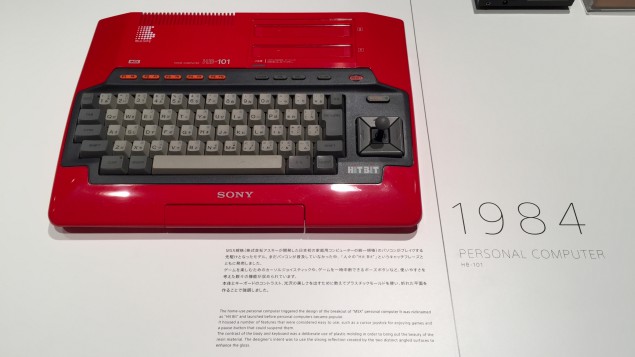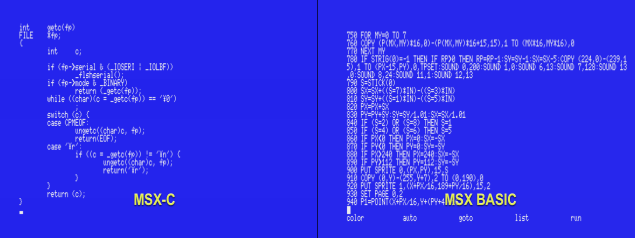Category Archives: MSX
Sony Design exhibition in Ginza: MAKING MODERN
Posted by Javi Lavandeira in Culture,Design,Japan,MSX,Retro,Technology | May 6, 2015If you’re following me on Facebook or Twitter then you already learnt about this earlier today:
This morning we went to Ginza for some important shopping, and afterwards we headed for the Sony Building. The reason: an exhibition opened there last week about the design of Sony products, and they have on display one of the coolest-looking MSX computers ever produced: a red HIT-BIT HB-101.
Sony Design: MAKING MODERN
Place: Sony Building (8th floor), Ginza
Admission fee: Free
Companion book: Sony Design: Making Modern
Held from April 29th to June 14th, 2015
Relearning MSX #18: Structure of an MSX-C program
Posted by Javi Lavandeira in MSX,Retro,Technology,Uncategorized | March 20, 2015In the last post we saw a very brief example of command line parameters, and we learnt about input/output redirection and pipes.
This week we’re going to see the structure of a program written in C. This post is intended as an introduction for users who haven’t programmed in the C language before. If you have coded anything in C before then you can completely skip it.
A few characteristics of C programs
If you’ve been an MSX user for a long time then it’s likely that you’ve seen lots of MSX BASIC programs. If that’s the case, then you’ll immediately notice several differences:
Read more ›Relearning MSX #17: Command line parameters, redirection and pipes
Posted by Javi Lavandeira in MSX,Retro,Technology | March 13, 2015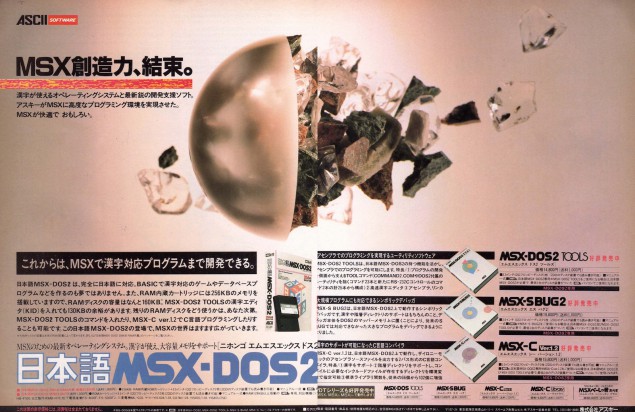
We now have a working installation of the MSX-C compiler. We saw a very simple test program in chapter 12, and this week we’ll compile a program that actually does something.
We’re going to learn about:
- Command line parameters
- Input/output redirection
- Pipes
Along the way we’re also going to see some common compile-time errors and how to resolve them. This post doesn’t require or assume any previous programming experience. The content and example programs are based on chapter 4 of the book MSX-C入門上巻 (“Introduction to MSX-C, first part”) edited by ASCII Corporation in 1989.
Before we start go get something to drink. This is a long post.
Read more ›Index of technical articles on MSX Magazine
Posted by Javi Lavandeira in MSX,Retro,Technology | March 12, 2015For my own reference I’ve compiled a list of all the technical articles that appeared in the Japanese MSX Magazine published by ASCII between 1983 and 1992. These articles are a fantastic source of information on the MSX architecture and how to develop software and hardware for it, even without previous knowledge of programming or electronics.
I have entered the article titles as they are, because this index won’t be very useful to you anyway if you can’t read Japanese.
Download it here:
- msx_magazine_articles.pdf (197 KB)
All of the MSX Magazine issues have been available for some time at the Internet Archive. This search will find most of them.
It’s been a while since the last post. This one isn’t technical at all. I’m just going to explain where we’re going from this point. Also, starting this week I’m setting a fixed schedule: one new post every Friday. This should keep you (and me) busy.
In the next posts we’re going to follow the Introduction to MSX-C (MSX-C入門) books published by ASCII. Both have been out of print for a long time, but they can still be found from time to time in Japanese second hand book stores and auctions. We’ll see everything in these books until we complete them, and then we’ll go to more technical stuff.
PDF versions of these were distributed with the MSX Magazine Revival issue #3 (MSXマガジン永久保存版3) in 2005. Both PDFs have been available online on the Internet Archive for some time (see links below).
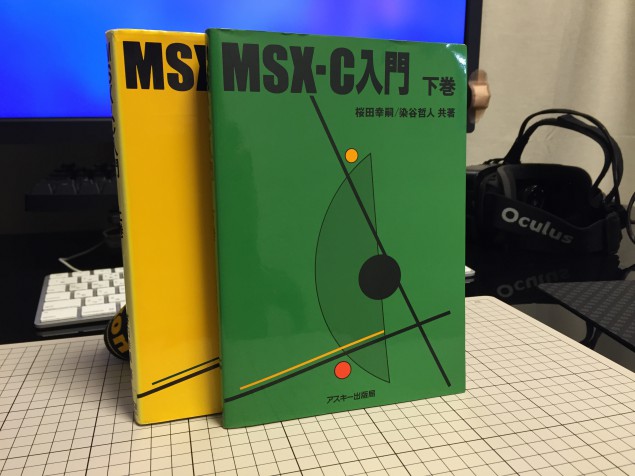
Introduction to MSX-C (Yellow: first part, Green: second part)
Relearning MSX #15: MSX-C commands: CG.COM
Posted by Javi Lavandeira in How-to,MSX,Retro,Technology | February 18, 2015In the previous two posts we’ve seen a detailed description of CF (MSX-C’s parser) and FPC (MSX-C’s function parameter checker). Today we’ll see the last one: CG.COM, MSX-C’s code generator.
What I said about the previous two articles applies to this one as well: this explanation is for experienced users who want to have more control over the compile process. If you’re a beginner then you don’t need to bother paying too much attention to this (yet). However, it won’t hurt to at least skim it and find out what are the available options.
Read more ›Relearning MSX #14: MSX-C commands: FPC.COM
Posted by Javi Lavandeira in How-to,MSX,Retro,Technology | February 16, 2015This is the second post describing MSX-C’s command line tools. In the previous article we examined the parser (CF.COM), and today we’ll see the Function Parameter Checker (FPC.COM).
As before, this post is rather technical and assumes experience programming in C. It’s targetted at users who already have experience programming in C. However, I still recommend to read it at least once if you’re a beginner, because it will familiarize you with problems you’ll find in the future.
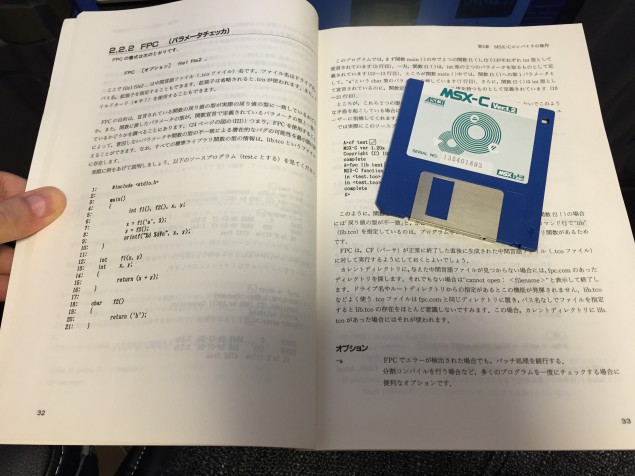
The MSX-C Ver.1.2 manual and disk
Relearning MSX #13: MSX-C commands: CF.COM
Posted by Javi Lavandeira in How-to,MSX,Retro,Technology | February 13, 2015It’s been a while since the last post in this series. At the end of the previous chapter we had a working installation of MSX-C Ver 1.2 with the MSX-C Library package.
Today’s post and the few that follow are a lot more technical. What comes now is a detailed description of the command line programs that compose the MSX-C compiler. The purpose is to allow users who already have some experience programming in C to dive deeper into software development in the MSX platform. If you’re new to compilers and the C language then this probably won’t make much sense yet, and that’s ok. We’ll go back to the basics after explaining these tools.
The information here comes from the books MSX-C Ver.1.2 User’s Manual and the Introduction to MSX-C (MSX-C入門上巻), both by ASCII Corporation.
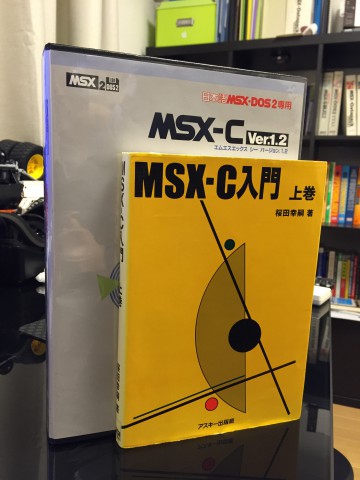
MSX-C Ver.1.2 package and the Introduction to MSX-C book
Do you support MSX development? Then donate to developers
Posted by Javi Lavandeira in MSX,Rants,Retro | January 20, 2015This shocked me yesterday. If you’re an MSX user then you may have heard about Nestor Soriano (AKA konamiman). He’s the guy who developed:
- Nextor, a new operating system for MSX (which I will talk about in the future on this blog), fully compatible with MSX-DOS2 and with FAT16 support
- NestorBASIC, an extended, more powerful version of MSX BASIC
- NestorPreTer, a new MSX BASIC preprocessor to make programming in MSX BASIC easier
- InterNestor Lite, a full TCP/IP stack for MSX2/2+/turbo R computers (yes, allows you to connect your MSX to the Internet)
- A bunch of Internet applications for MSX, including Dropbox, Twitter, FTP, Windows shared folders, clock synchronization via NTP, wget client…
- Firmware for MSX peripherals: ObsoNET and DenYoNet (Ethernet cards for MSX), MegaFlashROM SCC+ SD (interface to use SD cards as hard drives on the MSX), Tecnobytes’ IDE cartridge, etc.
If you’re keeping your MSX equipment up to date, the chances are high that you’re using for free something he has created, because that’s what he does: he gives all of this to the MSX community for free.
So what shocked me yesterday?
Read more ›Relearning MSX #12: Setting up the MSX-C environment (part 6)
Posted by Javi Lavandeira in How-to,MSX,Retro,Technology | January 17, 2015During the last few posts we’ve finished setting up the MSX-C environment and we’ve learnt how to use the AKID text editor. At this point we can already create and compile C programs, but the process is annoying because we have to run all the compiler steps by hand.
In this post we’re going to create a couple of batch files: one to set up some useful parameters in MSX-DOS2, and another to automate compilation of our C programs.
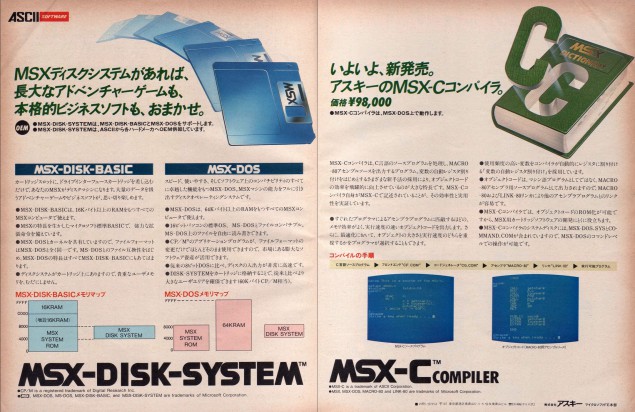
MSX-C ad from 1985. Yes, it was THAT expensive (MSX Magazine, May 1985)
AUTOEXEC.BAT
The first file we’re going to create is called AUTOEXEC.BAT, and it has to be created in the in the top directory of the boot disk (A:). If you used MS-DOS then you already know what it is.
Read more ›

